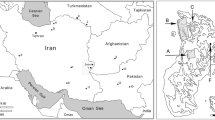Abstract
A preliminary survey of the microstructures and compositions of representative ceramic styles using minimally invasive analytical techniques provides a method of gaining insight into the materials and techniques of ceramic production dating from the eleventh to twelfth centuries C.E. at the archaeological site of Aktobe and from the 14-15th centuries C.E. at Aspara in southeastern Kazakhstan, both walled cities on the Silk Road trading corridor. The case is made for local production based on the argument of technological style or patterning of practices. Seven ceramic sherds representative of glazed earthenware and stoneware traditions were selected for study from excavations of Y. Akimbek and others that are maintained at the Institute of History and Archaeology of the Republic of Kazakhstan in Almaty. Fragments from serving bowls, a cup and bottle were studied by optical microscopy (OM), scanning electron microscopy with energy dispersive x-ray spectroscopy (SEM-EDS), electron beam microprobe analysis (EPMA) and refiring tests of the bodies and glazes. This initial study aims to characterize the range of physical and chemical variability of ceramics either produced at or imported into Aktobe and Aspara. Most stylistic studies consider these ceramics to have been imported from the Silk Road trade routes that connected many Central Asian cities. The styles include an imitation lusterware bowl made with a ground chromite underglaze pigment, a copper turquoise and cobalt blue and black painted white slipped alkaline-glazed cup, two green lead-glazed copper bowls, an imitation three-color of Chinese sansai bowla four-color lead-glazed bowl with underglaze mottled red, gray and black painted slips on a white slipped background and a stoneware bottle. Comparison of the weight ratios of the glaze compositions to possible plant ash raw material sources is presented as a possible way of studying raw material variability; however, analysis is complicated by having two other possible sources that may have supplied fluxing agents, including, salts present in the clays and salts from evaporite deposits.
Similar content being viewed by others
References
Akimbek, Yeraly, “Inscriptions on Ceramics of Medieval City Aktobe,” Procedia of Social and Behavioral Sciences, Kazakhstan, 122, pp. 77–81 (2014).
P.B. Vandiver et al., Archaeomaterials, vol. 5, no. 2, pp. 185–207 (1991).
C. Chang and K.S. Guroff, eds., Of Gold and Grass: Nomads of Kazakhstan, The Foundation for International Arts and Education, Bethesda, MD, pp. 145–154 (2006).
Alan Caiger-Smith, Lustre Pottery, Faber and Faber Ltd, London (1985).
Alan Caiger Smith, Aldermaston Pottery, 1955–1993, London (2006).
Anne-Marie Keblow Bernsted, Early Islamic Pottery, Archetype, London, pp. 7–10 (2003).
W.D. Kingery and P.B. Vandiver, Ceramic Masterpieces, Free Press, New York, p. 111–121 (1986).
I. Borgia, et al., in Applied Physics A, vol. 79, no. 2, pp. 257–261 and 369–372 (2004).
P.C. Guttierez et al., “Composition, Nanostructure, and Optical Properties of Silver and Silver-copper Lusters,” Jour. Am. Ceram. Soc., 93 [8], pp. 2320–2328 (2010).
T. Pradell, G. Molina, J. Molera and M.S. Tite, “Composition of the Lustre Pigment Used in the Production of Thirteenth Century A.D. Raqqa Lustreware from Syria,” Archaeometry, 58, pp. 979–986 (2016).
Paul Randohr, The Ore Minerals and Their Intergrowths, Pergamon Press, Oxford, UK, pp. 923–931 (1969).
M.F. Heinsch, P.B. Vandiver, K. Lyublyanovics, A.M. Choyke, C. Reedy, P. Tourtellotte, and C. Chang, “Ceramics at the Emergence of the Silk Road: A Case of Village Potters from Southeastern Kazakhstan during the Late Iron Age,” Materials Issues in Art and Archaeology, vol. 10, 31 pp., 2013, in press; and P.B. Vandiver, “Survey and Study of Kazakh Clay Resources from Almaty to the Chinese Border,” unpublished study (2017).
J. L. **e, F. He and C. Xu, Jour. of Soc. of Glass Technology, vol. 36, p. 139ff (1995).
P.B. Vandiver, et al., in Conservation of Ancient Sites on the Silk Road: Proc. of the Second Int’l. Conf. on the Conservation of Grotto Sites, Neville Agnew, ed., Getty Publications, Los Angeles, pp. 234–248 (2010).
O.S. Rye and C. Evans, Traditional Pottery Techniques of Pakistan, Smithsonian Contributions to Anthropology, no. 21, Smithsonian Institution, Washington, D.C., pp. 148–149, 180–185 (1976).
S. Arnold and P.B. Vandiver, “Characterization of a Modern Ceramic from Balkh,” Afghanistan,” unpublished paper, 6 pp. (2015).
P.B. Vandiver, et al., “Replications of Critical Technological Processes and the Use of Replicates as Characterization Standards,” Materials Issues in Art and Archaeology VIII, MRS Symp. Proc., vol. 1047, pp. 353–371 (2008).
H. Wulff, Traditional Crafts of Persia, MIT Press, Cambridge, MA, (1966), and analysis of Wulff’s materials collected at Multan, Pakistan, in 1966, and residing in the National Museum of Natural History, Smithsonian Institution, Washington, D.C.
P.B. Vandiver, “Craft Knowledge as an Intangible Cultural Property: A Case of Samarkand Tiles and Traditional Potters in Uzbekistan,” Materials Issues in Art and Archaeology, vol. 7, P.B. Vandiver, J.L. Mass and A. Murray, eds., Mater. Res. Soc. Symp. Proc., vol. 852, pp. 331–352 (2005).
Author information
Authors and Affiliations
Rights and permissions
About this article
Cite this article
Vandiver, P.B., Arnold, S. & Akimbek, Y. Islamic Twelfth Century C.E. Glazes from Aktobe, Kazakhstan, and Comparison to Modern Practice in Afghanistan and Uzbekistan. MRS Advances 2, 2101–2133 (2017). https://doi.org/10.1557/adv.2017.299
Published:
Issue Date:
DOI: https://doi.org/10.1557/adv.2017.299




